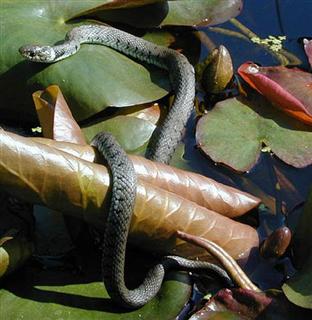European Grass Snake
European Grass Water Snake, Ringed Snake, Collared Snake Scientific Name: Natrix natrix
Mon, 28th April, 2025 - 8:04 am GMT
Sponsor Ads:

Alternative Name
European Grass Water Snake, Ringed Snake, Collared Snake Scientific Name: Natrix natrixBasic Info
The European Grass Snake usually grows to about three feet (180 centimeters) in length, and its slender body is usually an olive brown color. Variations of brown and green exist, as do black pigmentations. Females are larger than males and may grow up to five feet long. Many have black spots on their sides and back, and a yellow or white collar rings the neck of these snakes. Some have yellow rings around the black spots. Their collar gives them the names Collared or Ringed Snakes.
Health
In captivity, European Grass Snakes should be allowed a bowl to soak in and may appreciate a tub to swim in on occasion. They may be fed appropriately sized fish or rodents. A basking spot warmer than the rest of the terrarium may be of particular importance for this species, whose care is quite similar to that of many Garter Snakes. Breeding Generally, European Grass Snakes hibernate from about November to March. They often lay eggs between the months of June and October, in warm areas like rotting vegetative material or garden compost heaps. Often a clutch contains 30 eggs that will hatch into eight to ten inch long neonates. These young European Grass Snakes usually feed on insect larvae, earthworms, tadpoles, and fish.Habitat
It is often found in low vegetation near fresh water. European Grass Snakes also populate forested areas and grassland in addition to wetlands.Behavior
The European Grass Snake, with its rather plain though beautiful color pattern, is often a joy to keep as a pet.Unless you obtain a captive bred snake, it is best to leave this animal in the wild, since its numbers are flagging and wild caught populations must be preserved. Despite their land-oriented name, the European Grass Snake is a very good swimmer. They are often seen basking on cool sunny days in open areas. Although these snakes rarely bite and are not venomous, they can give off a rather disgusting odor when disturbed. They may also hiss when scared. It will draw itself up in a fierce imitation of a cobra and spit in an attempt to thwart the predator. If the European Grass Snake is extremely frightened, it will go into a dramatic enactment of death, flipping over onto its back and flopping its tongue out of its mouth.Origin
EuropeHistory
In its native Europe, the Collared Snake is no longer as common as it once was and it is protected by law in many areas. In these areas, it is illegal to keep, harass, or sell European Grass Snakes. There are thought to be about six subspecies of the European Grass Snake, mostly separated by range differences.Common Foods
European Grass Snakes eat a variety of amphibians, fish, lizards, and even small mammals.Sponsor Ads:
There are two periods in which Congress does no business: one is before the holidays and the other is after. -- Unknown
European Grass Snake
Coded by: BGID® | ALL RIGHTS RESERVED Copyright © 2000-2025
Disclaimer | Privacy | Report Errors / Contact | Credits








 President of the United States of America - Real Estate mogul, Pageant owner and now one of the most controversial men in political history.
President of the United States of America - Real Estate mogul, Pageant owner and now one of the most controversial men in political history.  Politician, US Vice President and President of the USA - Joseph Robinette Biden Jr.
Politician, US Vice President and President of the USA - Joseph Robinette Biden Jr.  versus
versus  Russia: 'The Evil Empire'? Are they all that bad or is it just the USA trying to portray Russia as bad because they are a world power with land bigger and a society very different from the USA ideal?
Russia: 'The Evil Empire'? Are they all that bad or is it just the USA trying to portray Russia as bad because they are a world power with land bigger and a society very different from the USA ideal?  Global warming has been in and out as the "latest" hot topic for many years. It is, according to modern scientists, the result of man-made industrial pollutants, clearing forested areas, agriculture, etc. But now they are thinking it started way before the Industrial Revolution...
Global warming has been in and out as the "latest" hot topic for many years. It is, according to modern scientists, the result of man-made industrial pollutants, clearing forested areas, agriculture, etc. But now they are thinking it started way before the Industrial Revolution... 
 Corona virus
Corona virus 
 Users with wide screen monitors can benefit from more content on every page.
Users with wide screen monitors can benefit from more content on every page.